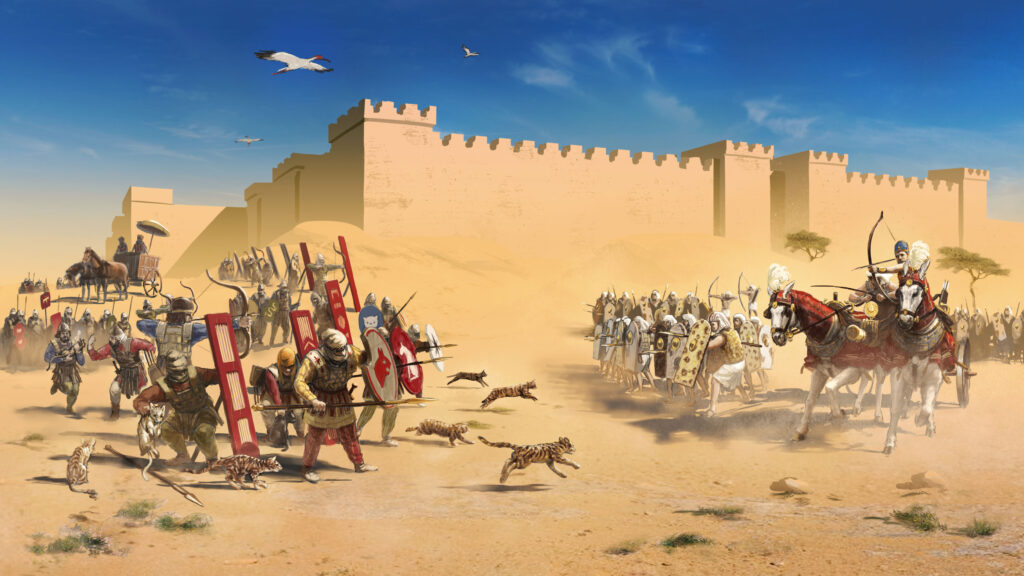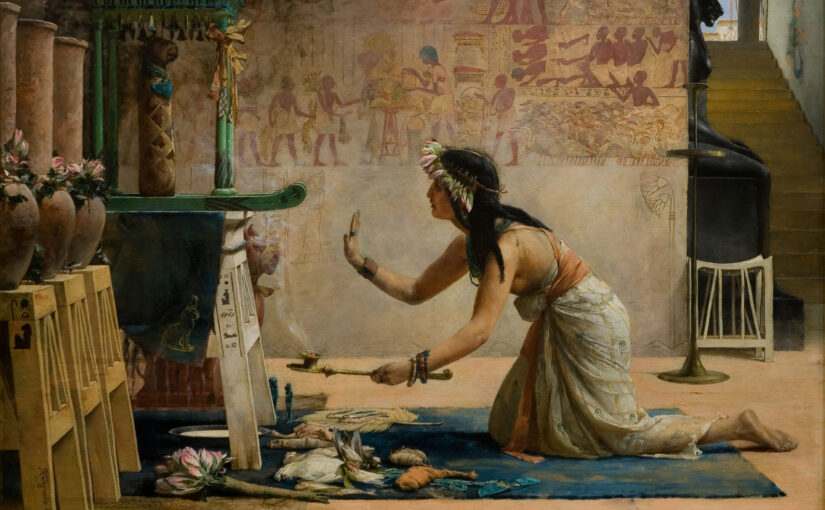For thousands of years, one animal has captivated humans with its mystery, elegance, and independence: the cat. Nowhere was this bond more powerful, or more visible, than in ancient Egypt. The Egyptians did not merely keep cats as pest controllers. They wove them into their households, their art, their funerary traditions, and even their religion. What began with a shy wildcat wandering near a village grew into one of the most distinctive human-animal relationships in history.
From Wild Hunter to Household Companion
Long before cats walked the streets of Thebes or lounged in the palaces of pharaohs, two types of wildcats prowled Egypt’s landscape: the jungle cat (Felis chaus) and the African wildcat (Felis silvestris lybica). It was the African wildcat, with fewer territorial instincts and a calmer disposition, that first dared to creep close to human settlements. Drawn by rodents feasting on stored grain, these small predators began a slow and cautious partnership with people.
Grain storage was an innovation that changed everything. Around the 16th century BCE, Egyptians built silos to safeguard their harvests. But harvests attracted mice and rats, which in turn drew the stealthy, whiskered hunters. The wildcats lingered near the silos, tolerated people, and eventually became part of daily life. Those with the gentlest temperaments thrived alongside humans, passing those traits to their litters. Over generations, “wild” blurred into “domestic.”
Modern science has even tracked this shift in feline DNA. In 2007, researchers studying the genome of an Abyssinian cat named Cinnamon discovered that genes tied to fear and motivation were under particular evolutionary pressure during domestication. What emerged were cats that could set aside their wariness and instead respond to rewards and human interaction. Humanity, it turns out, selected not for obedience but for charm.
Cats in Egyptian Art and Daily Life
By 1950 BCE, cats had clawed their way into Egyptian hearts and homes. An early tomb painting from roughly that year shows a lithe figure with upright tail and triangular head, stalking a rodent. It is the first known artistic depiction of a domestic cat.
At first, cats were shown primarily as working animals. In hunting scenes, they accompany their human companions into marshes, lunging after birds and fish. Later images show them seated under household chairs, patient but opportunistic, waiting to snatch food from the table. Over time, the depictions soften. In 15th and 14th century BCE tomb paintings in Thebes, cats wear delicate collars, pampered rather than merely tolerated.
Egyptian humor even shines through in whimsical papyrus cartoons. One illustration portrays a regal mouse waited on by feline servants, a playful reversal of life’s usual hierarchy. Other images capture domestic tranquility, where a cat reclines beneath a woman’s chair while a dog sits beneath a man’s. The archetype of the “cat lady,” it seems, was alive and well in the Nile Valley.
Death, Mourning, and the Journey Beyond
The Egyptians took their cats so seriously that harming one was considered a crime of the highest order. Accidentally killing a cat, even unintentionally, could be punished by death. In one infamous episode, a Roman soldier’s chariot ran over a cat. Despite a personal plea from Pharaoh Ptolemy, an outraged crowd executed the soldier on the spot, tearing him apart for the sacrilege.
When cats died naturally, entire families mourned. Everyone shaved their eyebrows as a public sign of grief. Wealthier households arranged elaborate funerals. Cats were embalmed, wrapped in colorful linen bands, and fitted with wooden masks before being laid in miniature feline-shaped sarcophagi. Some burials included dishes of milk and even mummified mice, ensuring well-fed journeys into the afterlife.
Archaeologists have uncovered striking examples of these practices. In the necropolis of Umm El Qa’ab, seventeen cat skeletons dating to the 20th century BCE were buried alongside small clay vessels, likely milk offerings. In Sakkara, archaeologists found two cats, Etak and Tikk, wrapped together with golden amulets around their necks and a papyrus bearing the print of a feline paw placed lovingly between their legs. For Egyptians, death was not the end. For their cats, it was merely another chapter.
The First Named Cats in History
Although most Egyptian cats were called simply “mau”—the very sound cats make—there are a few exceptions. Around 1450 BCE, a minor official named Puimre was buried outside Thebes. On the wall of his tomb, one detail stands out: his cat, “Nedjem,” which means “the Sweet One.” This cat holds the distinction of being the earliest animal known to us by personal name.
Other named cats followed. Prince Thutmose, around 1350 BCE, buried his feline companion in a limestone sarcophagus. He christened her “Ta-Miaut,” a name that translates literally as “the Cat.” Though uninspired, the sentiment mattered more than the creativity. To inscribe a name was to grant immortality.
From Household Pet to Divine Being
Cats eventually rose higher than any mortal could imagine. Egyptians did not just love cats. They revered them. At the center of this devotion was Bastet, the cat-headed goddess of fertility, motherhood, protection, music, and pleasure. Though she began as a fearsome lioness goddess, over time her form softened into that of a domestic cat. This shift mirrored the transformation of Egyptian society itself, from a land of untamed wilderness to one of cultivated fields and guarded cities.
Bastet embodied the traits Egyptians saw in their feline companions. Agile mothers, fierce defenders, graceful dancers, and vigilant protectors of the home: cats offered a mirror for divine power. Images of Bastet show a woman with a cat’s head, wielding a sistrum, a musical rattle, in one hand and a perfume vessel in the other. Her temples rang with dance and song, women shaking rattles carved with little cats during ecstatic festivals.
Nowhere was Bastet’s cult more powerful than in Bubastis, the “House of Bast.” Herodotus, the Greek historian, wrote of this dazzling city with tree-lined channels flowing from the Nile and great courtyards shaded by groves. Priests there bred living cats to be venerated as Bastet’s earthly representatives. Even pharaohs embraced her feline associations. One ruler took the throne name “Pamiu,” meaning “the Tomcat.”
Cats in Myth and Magic
The mythology around cats reflected both their mystery and their usefulness. One tale described the sun god Ra battling the chaos serpent Apophis. Ra descended into the underworld nightly in the form of a cat, where claws and fangs replaced burning rays of light. He slew the serpent with his knife of flint, ensuring the dawn’s return.
Egyptians also noticed the uncanny similarities between cats and snakes. A hissing cat echoed the sound of a serpent’s warning. A striped feline curled in sleep resembled a coiled viper. Cats even wagged their tails like striking cobras when cornered. For a people living among deadly snakes, such mimicry marked cats as allies and protectors.
Magic, too, clung to cats. Their night-shining eyes reminded Egyptians of the moon and the sun’s hidden power. Dreaming of a cat was considered a good omen, especially for harvests. Amulets in the form of cats were worn for protection. Even knives carved from ivory bore feline figures, serving more as charms than tools. The Egyptian word “mau” did not simply mean “cat.” It also meant “to see.” With their luminous eyes, cats were believed to pierce the darkness.
Cat Cults, Mummies, and Mass Rituals
The cult of Bastet reached dizzying popularity. Festivals dedicated to her regularly drew hundreds of thousands of worshippers. Women sang, drank, and danced in her honor, ridiculing restraint in ecstatic celebration. Yet amid this joy lay ritual sacrifice. Thousands of kittens were strangled or broken-necked, embalmed, and sold to pilgrims as votive offerings. Cat necropolises such as those at Bubastis, Saqqara, and Speos Artemidos became vast feline cemeteries filled with millions of mummified animals.
The demand sometimes outpaced supply. Priests resorted to wrapping incomplete remains, mixing genuine cat bones with fillers. Archaeologists today find such “fake mummies” by the thousands. Still, the sheer scale testifies to how deeply cats had infiltrated Egypt’s spiritual and economic life. Breeding cats, embalming them, and selling them as offerings became an industry.
Cats at War
The sacred status of cats was so profound that enemies of Egypt once used it against them. In 525 BCE, King Cambyses of Persia invaded the city of Pelusium. Knowing the Egyptians’ reverence for felines, he sent his soldiers into battle carrying cats. Afraid to harm the sacred animals, Egyptian troops faltered. The Persians won the city, in what might be the strangest tactical use of a pet in military history.

The Fall and Spread of the Cat Cult
For centuries, cats remained central to Egyptian religion and culture. But change eventually came. After the Roman conquest, the worship of Bastet and the sacred cult of cats spread outward across the empire, even reaching distant Britain. Yet within Egypt itself the practice slowly declined. By the fourth century CE the worship of feline deities was officially suppressed. The cults fell silent. The once sacred cat became once again a mere animal, though, as history shows, never entirely ordinary.
A Timeless Bond
The story of cats in ancient Egypt is one of transformation. Wild hunters of grain fields became household guardians, companions, and even gods. They adorned tomb walls, guided the souls of the dead, and earned names that have endured thousands of years. They mocked mice in playful papyri and stood beside Pharaohs as advisors in art. They were mourned like family members, mummified with reverence, and turned into symbols of eternal life.
Perhaps it is no accident that cats still carry an aura of mystery today. When your cat sits with eyes glimmering in the dark, it is easy to imagine the ancient Egyptians nodding with recognition, whispering: there lies a guardian of life and death, a creature who once walked with gods.
Header image: John Weguelin – The Obsequies of an Egyptian Cat – Google Art Project.
If you find joy in these tales of twitching whiskers and gleaming eyes, consider helping keep Whiskerito.com alive and purring. Your donation supports thoughtful research, engaging content, and the warm, wonder-filled community that makes this space what it is.
